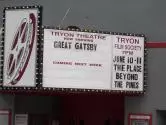Following Fitzgerald’s Footsteps

The best part of writing is not the publication, it’s the research.
And the best part of research is the occasional day trip in search of nuggets of information.
My next historical novel revolves around F. Scott Fitzgerald’s two years in western North Carolina, which included extended stays at the Grove Park Inn overlooking Asheville, in the Skyland Hotel in downtown Hendersonville (“a $2.00 a day hotel… eating 20 cent meals twice a day”), and at the Oak Hall Hotel in Tryon, a quaint resort village an hour’s drive south of Asheville.
Last Tuesday morning I followed the route Fitzgerald and his driving companion took on June 12, 1935, on their way to the home of the notorious Nora and Lefty Flynn, who between them managed to rack up seven marriages and countless love affairs, many of which were chronicled in the tabloids of the era. As a junior fullback in 1912, Lefty had led Yale’s football squad to within one game of a national championship, but then got drunk over Christmas break and woke up on a Monday morning married to a Broadway chorus girl. Needless to say, that ended Lefty’s collegiate career, but the handsome, 6′ 2″ star resurfaced in Hollywood, landing several roles as a leading man alongside starlets of the silent screen era, several of whom he became involved with off stage as well.
By the time Nora and Lefty had met, married and settled in Tryon in the 1930s, far beyond the reach of the New York and Hollywood reporters, they had redirected their extramarital energies into entertaining the Tryon socialites in their home outside town. To an envious Fitzgerald, Nora and Lefty Flynn represented the nouveau riche who never had to work for their money. In truth, the Flynns spent lavishly, running through Nora’s monthly allowance and relying on her family to cover their bounced checks around Tryon.
I arrived in Tryon famished, so treated myself to a second breakfast of the day, “Eggs, Grits and Greens” — two eggs over easy with fresh wilted spinach floating on a steaming bowl of cheddar cheese grits. Fortified for what I had hoped would be a day of reading through old copies of the Tryon Daily Bulletin, I walked up the hill to the one-story Lanier Library, named after musician and poet Sidney Lanier, who died near Tryon at age 39 from tuberculosis.
Unfortunately, the young librarian informed me that theirs was a circulating library, not a research facility.
Accustomed to running into dead ends, I was convinced the information I needed was somewhere in the small, tidy building, even if not on the bookshelves. I began telling the young librarian, in my characteristic loud teaching voice, the story of Fitzgerald and the Flynns, and before long had a small audience gathered around the front desk. Within minutes one person was on her phone to a local historian and two others were scribbling directions to “Little Orchard,” the home where Nora and Lefty Flynn hosted Fitzgerald, as well as other points of interest I wanted to explore.
I can’t say much in print about my journey out to Little Orchard, for fear of upsetting the current owners, who weren’t home that afternoon. I can say that I did pay homage to Nora Flynn, who remained at Little Orchard after Lefty divorced her, and whose ashes were scattered on the lawn after her death at age 65 from cancer.
I’ll have to save for another column my trip back home, which included a Charles Stickley china cabinet, my discovery of a feminist writer from the 1920s, and drinking red wine from a plastic cup next to the railroad tracks in Saluda.
As I was leaving Tryon, however, I could not help but stand in amazement and stare at the theatre marquee. There, directly across the street from the former site of the Oak Hall Hotel, where F. Scott Fitzgerald lived for nearly six months in 1937, in large bold letters was the announcement of this week’s feature film: The Great Gatsby.
Truth is still stranger than fiction.

Until next Monday,
Thanks for stopping by.
Bruce
